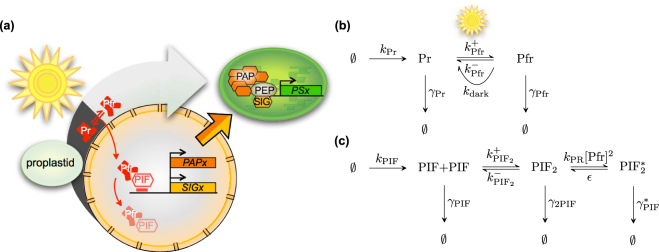Figure 3.
Model of light signaling of phytochrome B and PIF3. In (a) an illustration displaying the initiation of plastid gene expression by regulating PAP and SIG gene expression. Upon light induction phytochrome B transform to the active Pfr form which induce degradation of PIF3 and and thereby activating PIF3 repressed genes. (b) The reaction scheme of phytochrome production, decay and conversion between Pr and Pfr. Upon light induction, Pr is converted to Pfr and the ratio depends on the spectral composition of the light. In darkness, the dark reversion rate convert Pfr to the Pr form. The spectral composition of our light source have a red/far-red ratio of 10:1 making the Pfr form dominate in light. (c) The chemical reaction scheme of PIF3 in presence (and absence) of Pfr. In presence of Pfr, PIF3 is rapidly phosphorylated and degraded. This is captured in the model if the backward, un-phosphorylation, rate ε is small compared to the phosphorylation rate k PR[Pfr]2 and the decay rate .

